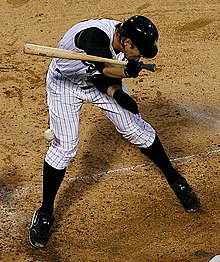Baseball statistics refers to a variety of metrics used to evaluate player and team performance in the game of baseball.
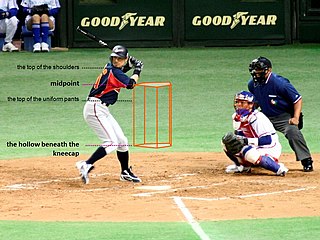
A base on balls (BB), better known as a walk occurs in baseball when a batter receives four pitches during a plate appearance that the umpire calls balls, and is in turn awarded first base without the possibility of being called out. The base on balls is defined in Section 2.00 of baseball's Official Rules, and further detail is given in 6.08(a). Despite being known as a "walk", it is considered a faux pas for a professional player to actually walk to first base; the batter-runner and any advancing runners normally jog on such a play.

Softball is a sport similar to baseball, and it is played with a larger ball on a smaller field and with only underhand pitches permitted. Softball is played competitively at club levels, the college level, and the professional level. The game was first created in 1887 in Chicago by George Hancock.

In baseball or softball, a strikeout occurs when a batter accumulates three strikes during a time at bat. It usually means that the batter is out. A strikeout is a statistic recorded for both pitchers and batters, and is denoted by K in scorekeeping and statistics. A "strikeout looking"—in which the batter does not swing and the third strike is called by the umpire—is usually denoted by a ꓘ.
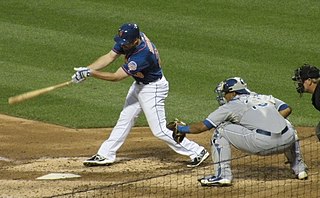
Catcher is a position in baseball and softball. When a batter takes their turn to hit, the catcher crouches behind home plate, in front of the (home) umpire, and receives the ball from the pitcher. In addition to this primary duty, the catcher is also called upon to master many other skills in order to field the position well. The role of the catcher is similar to that of the wicket-keeper in cricket.

In baseball, an intentional base on balls, usually referred to as an intentional walk and denoted in baseball scorekeeping by IBB, is a walk issued to a batter by a pitcher with the intent of removing the batter's opportunity to swing at the pitched ball. A pitch that is intentionally thrown far outside the strike zone for this purpose is referred to as an intentional ball.

In baseball and softball, the count refers to the number of balls and strikes a batter has in their current plate appearance. If the count reaches three strikes, the batter strikes out; if the count reaches four balls, the batter earns a base on balls.
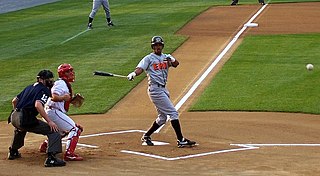
In baseball, a foul ball is a batted ball that:

Throughout the history of baseball, the rules have frequently changed as the game continues to evolve. A few common rules most professional leagues have in common is that four balls is a base on balls, three strikes is a strikeout, and three outs end a half-inning.
In baseball, interference occurs in situations in which a person illegally changes the course of play from what is expected. Interference might be committed by players on the offense, players not currently in the game, catchers, umpires, or spectators. Each type of interference is covered differently by the rules.

In baseball, a pitcher can commit illegal motions or actions that constitute a balk. Most of these violations involve pitchers pretending to pitch when they have no intention of doing so. In games played under the Official Baseball Rules that govern professional play in the United States and Canada, a balk results in a dead ball or delayed dead ball. In certain other circumstances, a balk may be wholly or partially disregarded. In the United States, under the National Federation of State High School Associations, a balk results in an immediate dead ball. In the event a balk is enforced, the pitch is generally nullified, each runner is awarded one base, and the batter (generally) remains at bat with the previous count. The balk rule in Major League Baseball was introduced in 1898.

In the sports of baseball and softball, a batted ball is a pitch that has been contacted by the batter's bat. Batted balls are either fair or foul, and can be characterized as a fly ball, pop-up, line drive, or ground ball. In baseball, a foul ball counts as a strike against the batter, unless there are already two strikes on the batter, with special rules applying to foul tips and foul bunts. Fly balls are those hit in an arcing manner, with pop-ups being a subset of foul balls that do not travel far. Line drives are batted balls hit on a straight line trajectory, while ground balls are hit at a low trajectory, contact the ground shortly after being hit, and then either roll or bounce. Batted balls, especially line drives, can present a hazard to players, umpires, and spectators, as people have been seriously injured or killed after being struck by batted balls.

Mario Melvin Soto is a Dominican former pitcher, mostly as a starter, for the Cincinnati Reds of Major League Baseball (MLB) from 1977 through 1988. He currently works in the Reds' front office.

In baseball, the lefty-righty switch is a maneuver by which a player who may be at a disadvantage against an opponent of a certain handedness is replaced by a substitute who is better suited for the situation.
Harry Hunter Wendelstedt Jr. was an American umpire in Major League Baseball who worked in the National League from 1966 to 1998. He was born in Baltimore, Maryland. He umpired in the World Series in 1973, 1980, 1986, 1991 and 1995, serving as crew chief in 1980 and 1995. He also officiated in seven National League Championship Series and four All-Star games, calling balls and strikes in 1976. He umpired in the National League Division Series in 1995, 1996 and 1997. He wore uniform number 21.

Jerry Blake Layne is an American umpire in Major League Baseball who has worked in the National League between 1989 and 1999, and throughout both major leagues since 2000. He wore uniform number 24 in the NL, but when MLB merged the AL and NL umpiring staffs in 2000, Layne was forced to switch to number 26, as AL umpire Al Clark, who also wore 24, had more seniority. When Clark was fired midway through the 2001 season by MLB, Layne reclaimed number 24 and has worn it ever since. With Joe West's retirement in 2022, Layne became MLB's most senior active umpire.
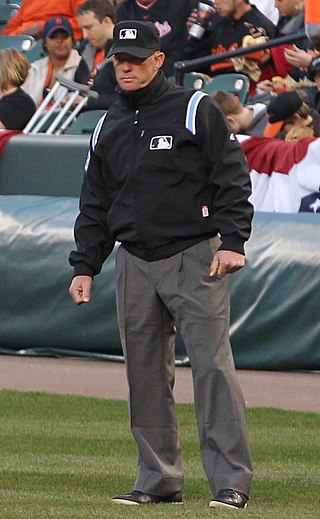
James Michael Wolf is an American Major League Baseball umpire. He joined the major league staff in 1999 after working in the Arizona Rookie League, the South Atlantic League, the California League, the Texas League and the Pacific Coast League. He wears uniform number 28.

Ronald Clarence Kulpa is an American umpire in Major League Baseball. He wears uniform number 46.
This is an alphabetical list of selected unofficial and specialized terms, phrases, and other jargon used in baseball, along with their definitions, including illustrative examples for many entries.
